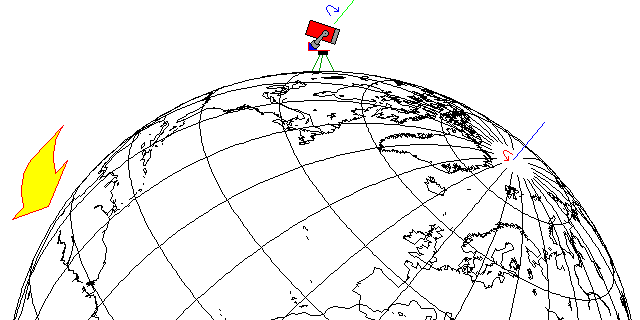
A telescope needs to sit on a steady base that also allows it to be turned and pointed in any direction.
This, in itself, is not a terribly complicated subject. However, there is one additional consideration which makes mounting an astronomical telescope more complicated, as illustrated by the diagram below.

Our intrepid astronomer must set his telescope down upon the surface of the Earth. And the Earth is rotating underneath his feet. This is what makes the Sun rise and set. Thus, as the Earth turns, our astronomer, in order to keep looking at the same star, must turn his telescope in the opposite direction.
To make this convenient, the telescope is mounted so that it is rotated around an axis which coincides with the Earth's axis. Then it can be tilted up or down to point at a particular star, by being rotated with respect to a perpendicular axis called the declination axis.
Thus, instead of rotating the telescope in a certain compass direction from where one is located (azimuth) and then tilting the scope up or down so that when the scope is tilted up, it is looking up at the same angle wherever the scope is turned (altitude), as is done in the plain, alt-azimuth, form of telescope mounting, to make it easier to follow stars, astronomical telescopes are usually mounted in a fashion similar to that shown here.
The kind of telescope illustrated in the diagram (of course, not to scale!) is a Schmidt-Cassegrain telescope on a fork mount. The telescope is rotated to point in different directions relative to a surface which is tilted to be at the same angle as the ground at the North Pole. A pole is actually shown in the diagram, to make the Earth's axis of rotation clearly visible. The circle in which the telescope rotates also matches the orientation of the Earth's equator, and this is why a telescope mount of this kind is called an equatorial mounting
Since the axis along which the telescope rotates must match that of the Earth, an equatorial mount must be situated in the right direction, a process known as polar alignment.
The diagram below illustrates the basic types of equatorial mounting, as used both for amateur and professional telescopes:
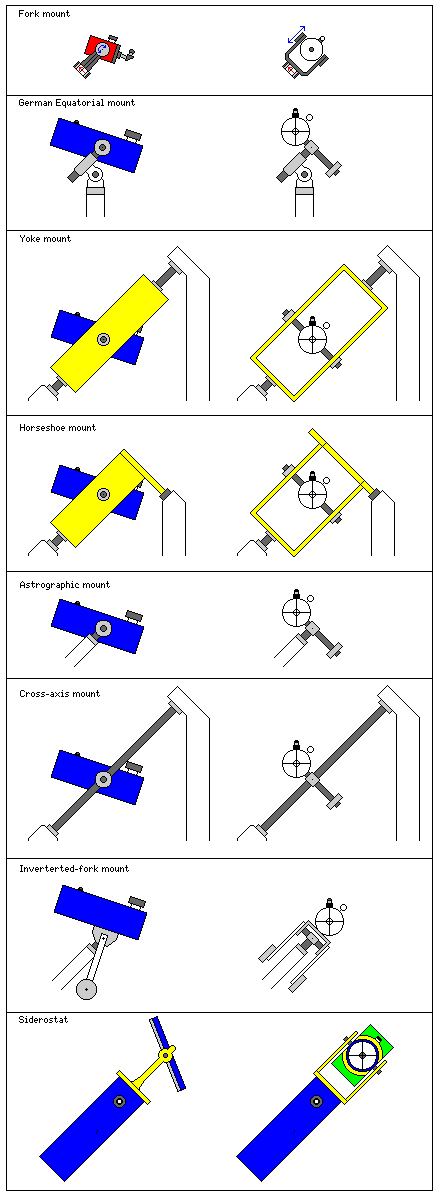
The fork mount holds the telescope in the center of two supports, on a platform which rotates to follow the Earth's polar axis.
The German Equatorial mount, invented by Fraunhofer, has instead one central pivot. The telescope is balanced by counterweights in order to allow it to be positioned freely.
Books on astronomy describe a number of other different ways of mounting telescopes.
The English mount or yoke mount addresses a problem with the fork mount: the fork itself still experiences an unbalanced load from the telescope, which means the base of the fork must be of heavy construction. The yoke mount solves this by placing the telescope between two forks, but this prevents the telescope from being pointed at stars close to the north celestial pole.
The horseshoe mount is a design that avoids the limitation of the yoke with respect to objects near the pole. It involves mounting the telescope in a frame like this:
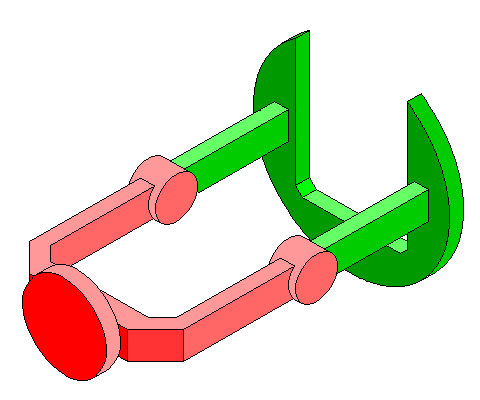
Here, the part shown in red is a fork mount, and the part shown in green is the part added for this variation on the yoke mount. The large round element at the top can be turned in a matching cradle, thus ensuring the weight of the telescope is supported on both sides of the place where it is attached to the mount. Because of the opening cut into it, it is still possible to point the telescope directly at Polaris and at stars near it. This is the type of mounting used for the 200-inch Hale telescope at Mount Palomar.
Variations on the German Equatorial mount also exist.
The Astrographic mount is a German Equatorial, but with the axis pointed to the North Pole on a pillar which is tilted in the same direction. This avoids a problem with the German Equatorial, where the vertical pillar blocks the motion of the telescope when following stars north of the point directly overhead (the zenith) as the Earth rotates.
The cross-axis mount uses a long axis, braced at both ends. This improves the rigidity of the mounting, and also avoids the blockage found in the straightforward German Equatorial.
The inverted-fork mount is a design sometimes recommended for a beginner's first telescope with an equatorial mounting. As we can see from the diagram of different types of mountings, which shows two views of each type of mount from the same direction, but with the telescope rotated to two different positions, it can be regarded as a development of the Astrographic variation of the German Equatorial. The pivot point is the same, but now the telescope is above the pivot point instead of to one side of it, and the counterweights are moved correspondingly.
The siderostat attempts to simplify the problem of equatorial mounting by having the telescope always point in the direction of the celestial pole, and merely placing a light flat first-surface mirror in front of the telescope. This is limited in the area of the sky it can view; this limitation can be removed by keeping the flat mirror shown always at a 45 degree angle, and placing another mirror, also at a 45 degree angle to the new optical axis, but rotatable, in front of it, at the cost, of course, of a second additional reflection with additional loss of light.
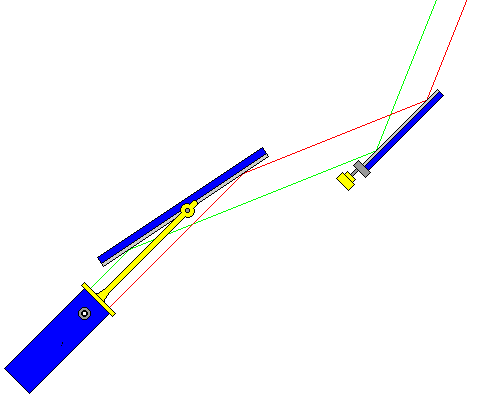
Unlike the other equatorial mounts shown here, a siderostat behaves like an altazimuth telescope in one important respect: as it tracks a moving object in the sky, the image of that object rotates in the eyepiece. A variation on the siderostat, called the coelostat, as shown in the illustration above, corrects this weakness.
In the case of the coelostat, the clock drive turns a second mirror about an axis of rotation corresponding to the Earth's axis. The red and green lines showing rays of light in the diagram illustrate how the orientation of the light fed to the telescope remains constant as that second mirror rotates.
One thing to note is that when a coelostat is pointed at an object on or sufficiently near to the celestial equator, or below the celestial equator, the first mirror or the telescope itself will obstruct the line of sight at the midpoint of the rotation of the second mirror; this means that the initial aiming of the telescope will need to be planned differently, and the time available for a continuous exposure is limited, but it does not prevent using the mounting to view such objects.
Instead of simply following a star by hand, an equatorially-mounted telescope can include a clock drive, which uses a motor to slowly turn the telescope in the opposite direction to the Earth's turning. It should be noted, though, for this purpose the Earth does not turn on its axis once every 24 hours; it actually points in the same direction again about four minutes earlier each day. Our 24 hour day marks the interval between times when the Earth points towards the Sun; since the Earth revolves around the Sun, "towards the Sun" is not really the same direction every day, and this accounts for the small discrepancy between the 24-hour or synodic day, and the rotation period of the Earth relative to the distant stars, the sidereal day.
Of course, with modern computer technology, alt-azimuth mountings for telescopes are making a comeback, since a computer can easily work out how to move a telescope both in altitude and azimuth to follow the same series of directions as an equatorially-mounted telescope would. This has the advantage that it is easier to make the telescope mounting strong and stable, since the weight of the telescope can now thrust straight down on the azimuth bearing of the mounting.
This, however, is not fully suitable for astrophotography, as although the telescope stays pointing in one direction, its orientation is not the same, and thus the image provided by the telescope will gradually rotate during the course of a night.
A telescope can be designed so that a Cassegrain secondary gives it a very long effective focal length, and so that a tertiary mirror just in front of the primary mirror reflects the light from the secondary out through the telescope's declination axis.
If an eyepiece or camera is placed at that point, so that it moves only with the fork mounting, and not the telescope itself, this constitutes making use of the Nasmyth focus.
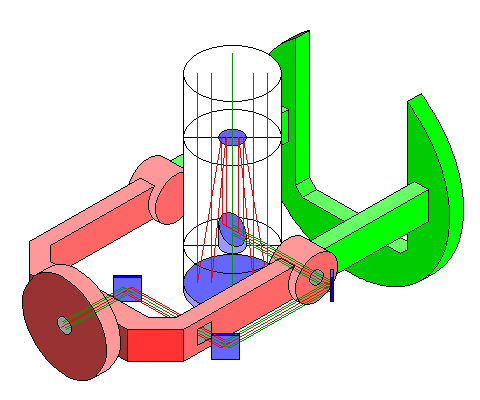
If additional mirrors used instead, as in the diagram above (along with relay lenses, which are not illustrated; also, note that coudé focus arrangements often will use mirrors at other angles than 45° so as to reduce the number of mirrors required by one compared to that shown in the diagram), so that the light leaves the telescope and mounting through the right ascension axis, the main axis of the equatorial mounting which is parallel to the Earth's axis of rotation, the telescope is being used at its Coudé focus.
While this could be used by lazy observers who do not wish to observe from a different position as they point the telescope to different parts of the sky, the main use of the Coudé focus is with large telescopes that are being used to obtain light for very large accessories, such as a spectrograph.
The illustration below

shows the four possible configurations of the Mount Wilson 60-inch telescope. It is taken from the famous paper On the Modern Reflecting Telescope, and the Making and Testing of Optical Mirrors by G. W. Ritchey, of Ritchey-Chrètien telescope fame. As can be seen, it is on an equatorial fork mount.
The different configurations shown, from left to right, are: the basic Newtonian configuration, at f/5, the basic Cassegrain configuration, at f/16, as used for spectroscopy, a modified Cassegrain configuration, at f/20, used for photography, and the Coudé configuration, currently no longer available on the instrument, at f/30.
The Mount Wilson 60-inch is often viewed as setting the pattern for modern optical telescopes in observatories around the world, and one aspect of this is that they can be set up for different optical configurations for different tasks.
Copyright (c) 2001, 2004 John J. G. Savard